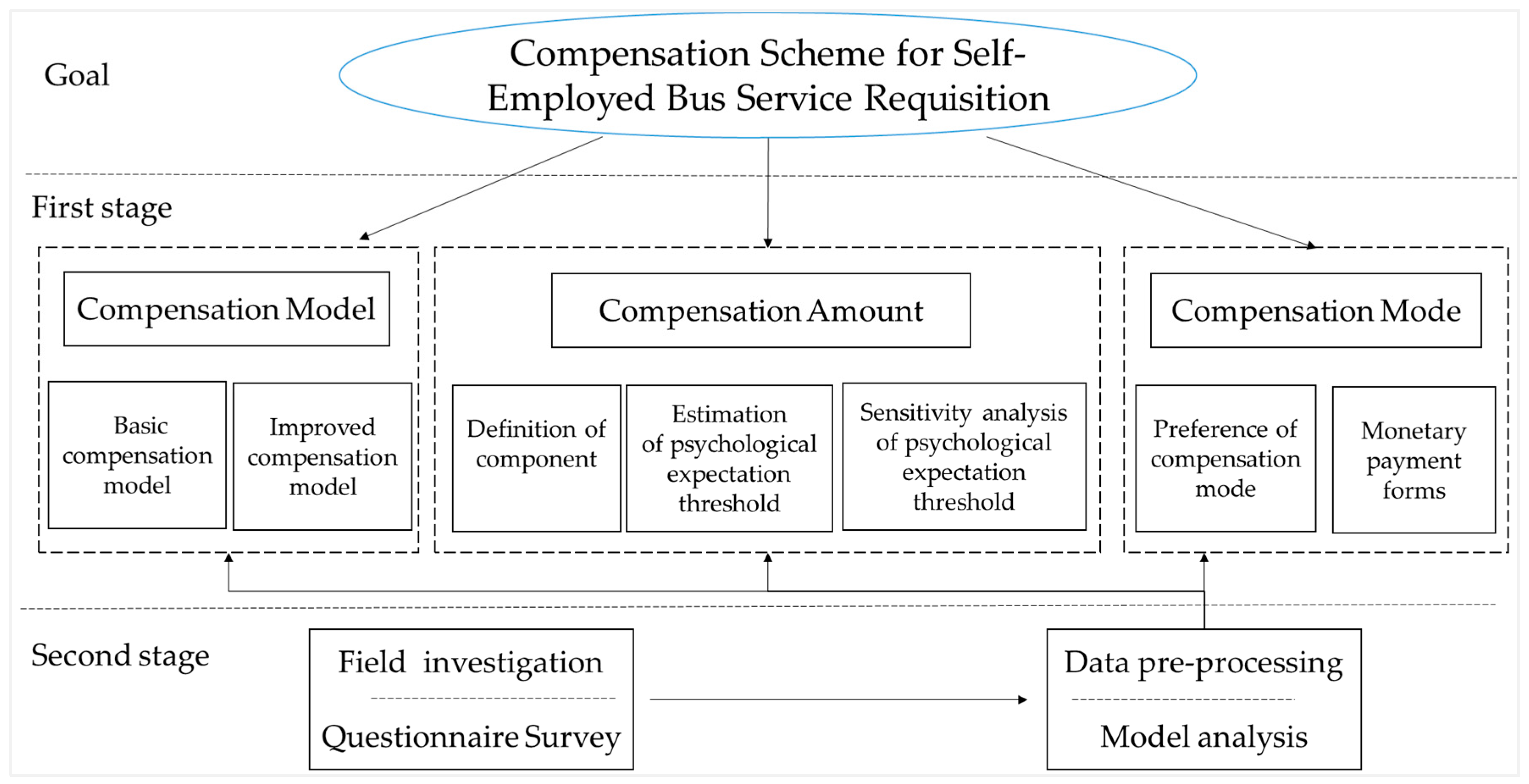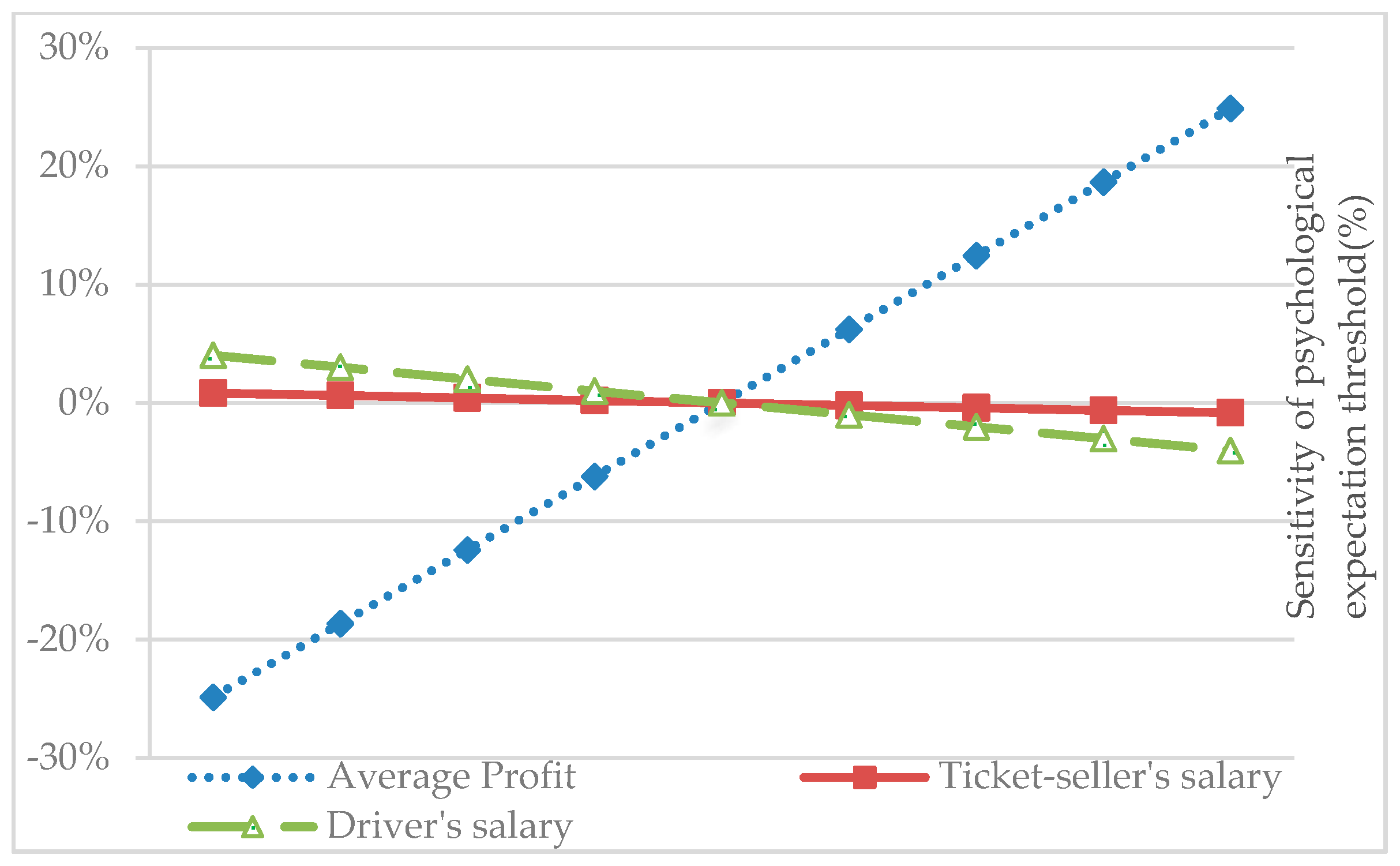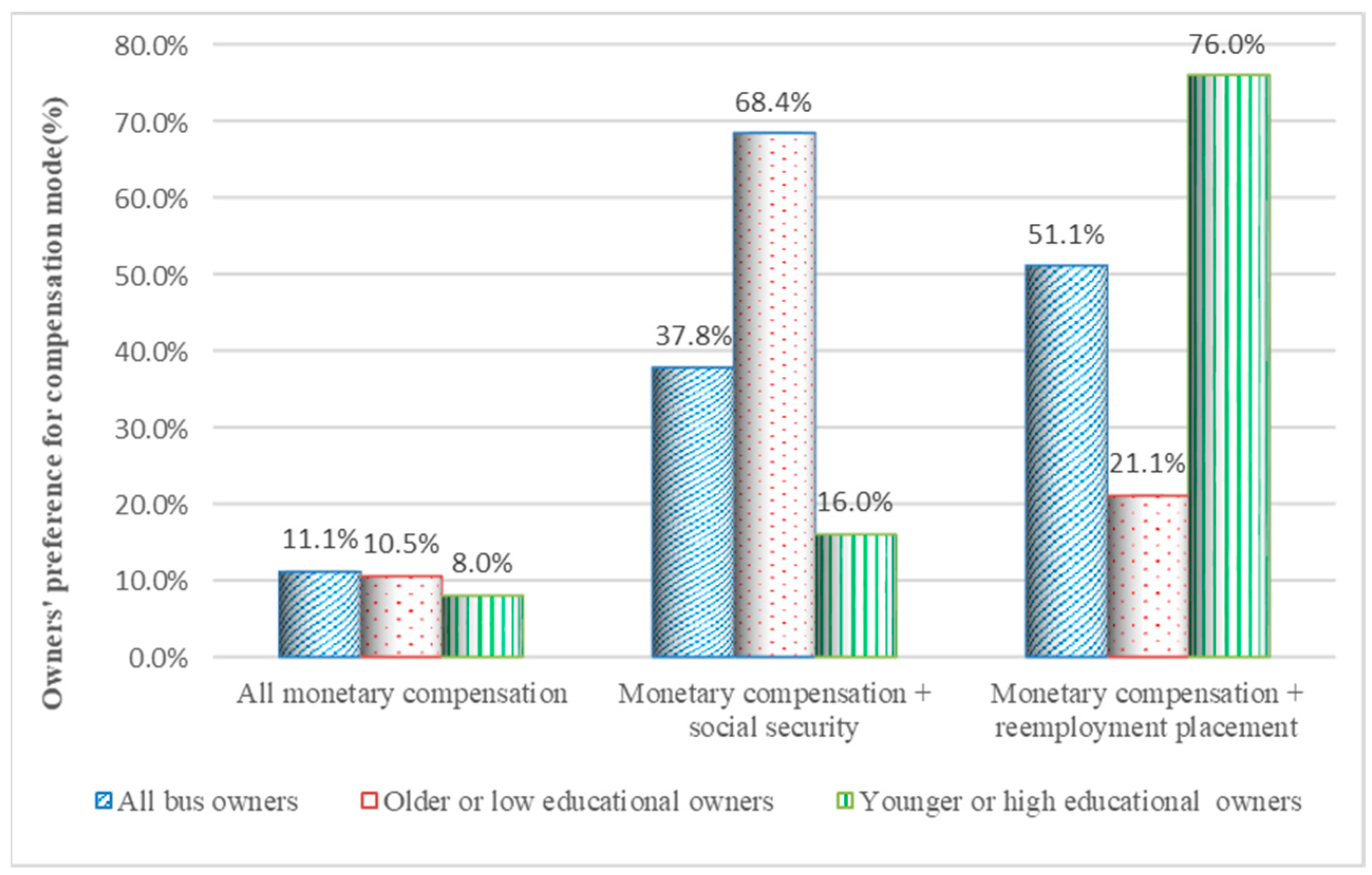Compensation Scheme for Self-Employed Bus Service Requisitions in Urban–Rural Passenger Transport
Abstract
1. Introduction
2. Materials and Methodologies
2.1. Construction of Compensation Model
2.1.1. Basic Compensation Model
2.1.2. Improved Compensation Model
- (1)
- represents the number of rural passenger bus requisitioned by the government. After the self-employed bus service requisition occurs, buses that meet the operating conditions will be put into operation again. After bus service are requisitioned by the government, the revenue of the bus services is , represents the average revenue of each bus after requisitioning.
- (2)
- represents the owner’s investment in each self-employed bus service. If the self-employed bus service is requisitioned by the government, all the investment will be completely destroyed.
- (3)
- The compensation amount given by the government for each self-employed bus service requisition is , which is the only cost paid by the government.
- (4)
- represents the social cost of each self-employed bus service requisition, where . If the owner fully accepts the compensation amount for the self-employed bus service requisition, then at this time.
2.2. Estimation of Compensation Amount
2.2.1. Compensation Amount
2.2.2. Estimation of Psychological Expectation Threshold
2.2.3. Sensitivity Analysis of Psychological Expectation Threshold
2.3. Determination of Compensation Mode
3. Empirical Analysis
3.1. Data Sources
3.2. Results Analysis
3.2.1. Measurements of Pet
3.2.2. Sensitivity Analysis of Pet
3.2.3. Compensation Mode
4. Discussion
4.1. Improving the Compensation Standard and Diversifying the Compensation Modes
4.2. Ameliorating the Participation Effect of Bus Owners and Perfecting the Conflict Mediation Mechanism
4.3. Improving the Information Transparency of the Compensation Scheme
5. Conclusions
Author Contributions
Funding
Acknowledgments
Conflicts of Interest
References
- Zhang, C.; Xiao, G.; Liu, Y.; Yu, F. The relationship between organizational forms and comprehensive effectiveness for public transport services in China? Transp. Res. Part A Policy Pract. 2018, 118, 783–802. [Google Scholar] [CrossRef]
- Ma, C.; Ma, C.; Ye, Q.; He, R.; Song, J. An improved genetic algorithm for the large-scale rural highway network layout. Math. Probl. Eng. 2014, 2014. [Google Scholar] [CrossRef]
- Timmermans, H. Decision Support Systems in Urban Planning; E. & F.N. Spon: London, UK, 2003. [Google Scholar]
- Roess, R.; Prassas, E.; McShane, W. Traffic Engineering (Fifth Edition); Pearson Education, Inc.: New York, NY, USA, 2004. [Google Scholar]
- O’Kelly, M.; Miller, H. The hub network design problem. A review and synthesis. J. Transp. Geogr. 1994, 2, 31–40. [Google Scholar] [CrossRef]
- Campbell, J.; O’Kelly, M. Twenty-five years of hub location research. transport. Science 2012, 46, 153–295. [Google Scholar]
- Papangelis, K.; Velaga, N.; Ashmore, F.; Sripada, S.; Nelson, J.; Beecroft, M. Exploring the rural passenger experience, information needs and decision making during public transport disruption. Res. Transp. Bus. Manag. 2016, 18, 57–69. [Google Scholar] [CrossRef]
- Gnap, J.; Settey, T.; Beňová, D. Examining the impact of air passenger transport on international long-distance regular bus transport in the Slovak Republic. MATEC Web Conf. 2018, 236, 02007. [Google Scholar] [CrossRef]
- Gong, L.Y.; Xu, Y.J.; Kong, Q.F.; Hu, T.J. Study on County planning of urban and rural passenger transport integration. Adv. Mater. Res. 2014, 962, 2590–2593. [Google Scholar] [CrossRef]
- Vuuren, D. Optimal pricing in railway passenger transport: Theory and practice in The Netherlands. Transp. Policy 2002, 9, 95–106. [Google Scholar] [CrossRef]
- Deb, K.; Filippini, M. Estimating welfare changes from efficient pricing in public bus transit in India. Transp. Policy 2011, 18, 23–31. [Google Scholar] [CrossRef][Green Version]
- Bly, P.; Oldfield, R. An analysic assessment of subsidies to bus services. Transp. Sci. 1986, 20, 200–212. [Google Scholar] [CrossRef]
- Anas, A. The optimal pricing, finance and supply of urban transportation in general equilibrium: A theoretical exposition. Econ. Transp. 2012, 1, 64–76. [Google Scholar] [CrossRef]
- Jørgensen, F.; Pedersen, H.; Solvoll, G. Ramsey pricing in practice: The case of the Norwegian ferries. Transp. Policy 2004, 11, 205–214. [Google Scholar] [CrossRef]
- Basso, L.; Guevara, C.; Gschwender, A.; Fuster, M. Congestion pricing, transit subsidies and dedicated bus lanes: Efficient and practical solutions to congestion. Transp. Policy 2011, 18, 676–684. [Google Scholar] [CrossRef]
- Tirachini, A.; Hensher, D.; Rose, M. Multimodal pricing and optimal design of urban public transport: The interplay between traffic congestion and bus crowding. Transp. Res. Part B Methodol. 2014, 61, 33–54. [Google Scholar] [CrossRef]
- Holmgren, J. Meta-analysis of public transport demand. Transp. Res. Part A Policy Pract. 2007, 41, 1021–1035. [Google Scholar] [CrossRef]
- Tsai, C.; Mulley, C.; Clifton, G. A review of pseudo panel data approach in estimating short-run and long-run public transport demand elasticities. Transp. Rev. 2014, 34, 102–121. [Google Scholar] [CrossRef]
- Kleinova, E. The Use of a consumer survey to determine the relevant market-case study for public transport between Prague and Most. Rev. Econ. Perspect. 2016, 16, 17–28. [Google Scholar] [CrossRef]
- Zhang, C.; Juan, Z.; Luo, Q.; Xiao, G. Performance evaluation of public transit systems using a combined evaluation method. Transp. Policy. 2016, 45, 156–167. [Google Scholar] [CrossRef]
- Borger, B.; Fosgerau, M. Information provision by regulated public transport companies. Transp. Res. Part B Methodol. 2012, 46, 492–510. [Google Scholar] [CrossRef]
- Tscharaktschiew, S.; Hirte, G. Should subsidies to urban passenger transport be increased? A spatial CGE analysis for a German metropolitan area. Transp. Res. Part A Policy Pract. 2012, 46, 285–309. [Google Scholar] [CrossRef]
- Qin, F.; Zhang, X. Designing an optimal subsidy scheme to reduce emissions for a competitive urban transport market. Sustainability 2015, 7, 11933–11948. [Google Scholar] [CrossRef]
- Hensher, D.; Ho, C.; Knowles, L. Efficient contracting and incentive agreements between regulators and bus operators: The influence of risk preferences of contracting agents on contract choice. Transp. Res. Part A Policy Pract. 2016, 87, 22–40. [Google Scholar] [CrossRef]
- Zou, W.; Yu, M.; Mizokami, S. Mechanism design for an incentive subsidy scheme for bus transport. Sustainability 2019, 11, 1740. [Google Scholar] [CrossRef]
- Li, X.; Shan, R.; Shang, J. Micro-economic based analysis of financial grant model for rural passenger. Transp. J. Highw. Transp. Res. Dev. 2008, 8, 25–154. [Google Scholar]
- Lin, L.; Jia, H.; Pan, Y.; Qiu, L.; Gan, M.; Lu, S.; Deng, J.; Yu, Z. Exploring the patterns and mechanisms of reclaimed arable land utilization under the requisition-compensation balance policy in Wenzhou, China. Sustainability 2018, 10, 75. [Google Scholar] [CrossRef]
- Chen, W.; Ye, X.; Li, J.; Fan, X.; Liu, Q.; Dong, W. Analyzing requisition-compensation balance of farmland policy in China through telecoupling: A case study in the middle reaches of Yangtze River Urban Agglomerations. Land Use Policy 2019, 83, 134–146. [Google Scholar] [CrossRef]
- Liu, L.; Liu, Z.; Gong, J.; Wang, L.; Hu, Y. Quantifying the amount, heterogeneity, and pattern of farmland: Implications for China’s requisition-compensation balance of farmland policy. Land Use Policy 2019, 81, 256–266. [Google Scholar] [CrossRef]
- Czwajda, L.; Kosacka-Olejnik, M.; Kudelska, I.; Kostrzewski, M.; Sethanan, K.; Pitakaso, R. Application of prediction markets phenomenon as decision support instrument in vehicle recycling sector. LogForum 2019, 15, 265–278. [Google Scholar] [CrossRef]
- Nash, J. Non-cooperative games. Ann. Math. 1951, 54, 286–295. [Google Scholar] [CrossRef]
- Kostrzewski, M. One design issue–Many solutions. Different perspectives of design thinking–Case Study. In Proceedings of the International Conference on Knowledge Management in Organizations, Zilina, Slovakia, 6–10 August 2018; pp. 179–190. [Google Scholar]
- Papageorgiou, G.; Damianou, P.; Pitsillides, A.; Aphamis, T.; Ioannou, P. Modelling and simulation of transportation systems: Planning for a bus priority system. In Proceedings of the 6th EUROSIM Congress on Modelling and Simulation, Ljubljana, Slovenia, 9–13 September 2007. [Google Scholar]
- Kostrzewski, M. Implementation of distribution model of an international company with use of simulation method. Procedia Eng. 2017, 192, 445–450. [Google Scholar] [CrossRef]






| Scheme | Government | ||
|---|---|---|---|
| No Requisition | Requisition | ||
| Bus owner | Accept | ||
| Reject | |||
| Scenarios | Type of Bus Line | Time t of Signing the Compensation Agreement | Compensation Amount C | |||
|---|---|---|---|---|---|---|
| Cold Line | Hotline | t ∈ [t1, t2] | t ∈ [t1, t2] | Others | ||
| Scenario 1 | √ | N.A. | √ | N.A. | N.A. | |
| Scenario 2 | √ | N.A. | N.A | √ | N.A. | |
| Scenario 3 | √ | N.A. | N.A | N.A. | √ | |
| Scenario 4 | N.A. | √ | √ | N.A. | N.A. | |
| Scenario 5 | N.A. | √ | N.A. | √ | N.A. | |
| Scenario 6 | N.A. | √ | N.A. | N.A. | √ | |
| Volatility Range | ||||||
|---|---|---|---|---|---|---|
| −20% | 104,508 | −24.90% | 140,244 | 4.00% | 144,680 | 0.80% |
| −15% | 113,152 | −18.60% | 139,954 | 3.00% | 143,281 | 0.60% |
| −10% | 121,795 | −12.40% | 139,664 | 2.00% | 141,882 | 0.40% |
| −5% | 130,439 | −6.20% | 139,373 | 1.00% | 140,482 | 0.20% |
| 0% | 139,083 | 0.00% | 139,083 | 0.00% | 139,083 | 0.00% |
| 5% | 147,727 | 6.20% | 138,793 | −1.00% | 137,684 | −0.20% |
| 10% | 156,371 | 12.40% | 138,502 | −2.00% | 136,284 | −0.40% |
| 15% | 165,014 | 18.60% | 138,212 | −3.00% | 134,885 | −0.60% |
| 20% | 173,658 | 24.90% | 137,922 | −4.00% | 133,485 | −0.80% |
| Sensitivity | High | Medium | Low | |||
| Compensation Modes | All Bus Owners | Older or Low Education Owners | Younger or High Education Owners | |||
|---|---|---|---|---|---|---|
| Count | Percentage | Count | Percentage | Count | Percentage | |
| All monetary compensation | 29 | 11.11% | 16 | 10.53% | 8 | 8.00% |
| Monetary compensation + social security | 99 | 37.78% | 107 | 68.42% | 17 | 16.00% |
| Monetary compensation + reemployment placement | 134 | 51.11% | 33 | 21.05% | 81 | 76.00% |
| Sum | 262 | 100% | 156 | 100% | 106 | 100% |
| Acceptance Degree | One-Time Monetary Payment | Expected Income Dividend Installment | ||
|---|---|---|---|---|
| Count | Percentage | Count | Percentage | |
| No acceptance | 160 | 61.1% | 62 | 23.8% |
| Uncertain | 58 | 22.2% | 37 | 14.3% |
| Acceptance | 44 | 16.7% | 162 | 61.9% |
| Sum | 262 | 100% | 262 | 100% |
© 2019 by the authors. Licensee MDPI, Basel, Switzerland. This article is an open access article distributed under the terms and conditions of the Creative Commons Attribution (CC BY) license (http://creativecommons.org/licenses/by/4.0/).
Share and Cite
Zhang, C.; Hu, Y.; Ni, A.; Li, H. Compensation Scheme for Self-Employed Bus Service Requisitions in Urban–Rural Passenger Transport. Sustainability 2019, 11, 4855. https://doi.org/10.3390/su11184855
Zhang C, Hu Y, Ni A, Li H. Compensation Scheme for Self-Employed Bus Service Requisitions in Urban–Rural Passenger Transport. Sustainability. 2019; 11(18):4855. https://doi.org/10.3390/su11184855
Chicago/Turabian StyleZhang, Chunqin, Yuting Hu, Anning Ni, and Hongwei Li. 2019. "Compensation Scheme for Self-Employed Bus Service Requisitions in Urban–Rural Passenger Transport" Sustainability 11, no. 18: 4855. https://doi.org/10.3390/su11184855
APA StyleZhang, C., Hu, Y., Ni, A., & Li, H. (2019). Compensation Scheme for Self-Employed Bus Service Requisitions in Urban–Rural Passenger Transport. Sustainability, 11(18), 4855. https://doi.org/10.3390/su11184855






